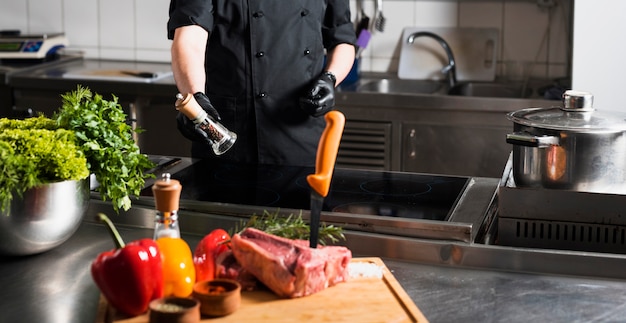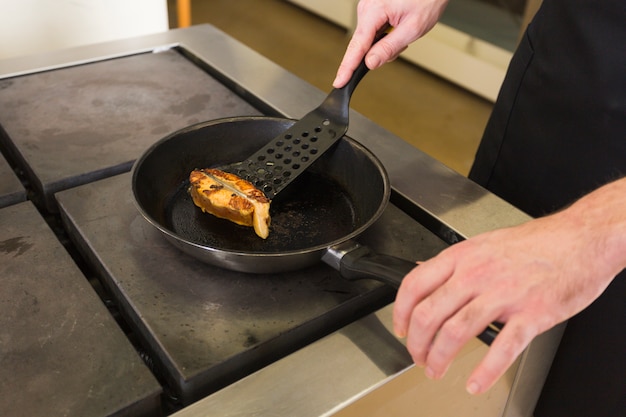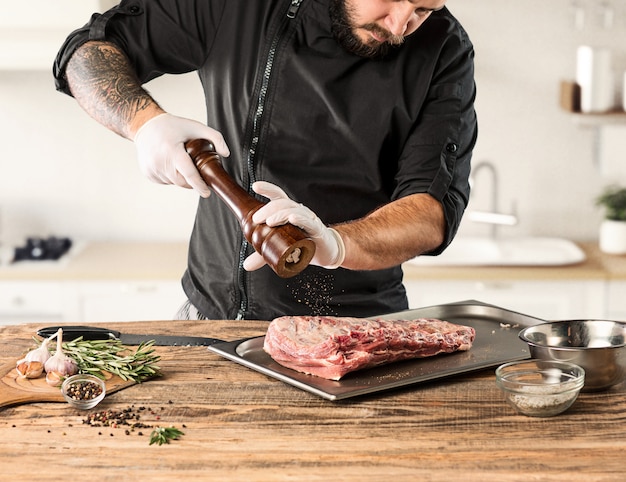(Part 1) Debunking the Searing Myth

(Part 2) The Science of Oven-Baked Steak: Heat Management is Key

(Part 3) choosing the right cut for Oven-Baked Success

- Rib Eye: This cut, with its generous marbling, is a true star of the show. It's incredibly juicy and tender, making it perfect for oven-baking. Just imagine that beautiful, flavorful fat melting into the steak as it cooks, creating a symphony of deliciousness.
- new york strip: Leaner than a ribeye, but still bursting with flavor, the New York Strip is a fantastic choice for those who prefer a slightly firmer texture. It's a cut that holds its own, and oven-baking enhances its natural elegance.
- Sirloin: A budget-friendly option that consistently delivers. It's a solid choice for a satisfying steak dinner, and it cooks beautifully to a juicy, flavorful medium-rare.
- flank steak: This thin, flavorful cut is best cooked to medium-rare or medium, as it can become tough if overcooked. But when cooked properly, it's incredibly tender and full of flavor. The oven-baking method is ideal for bringing out the best in flank steak.
(Part 4) Prepping for Perfection: A Little TLC for Your Steak
You've got your perfect cut of steak, now it's time to give it a little TLC. It's all about setting the stage for a beautiful, flavorful experience. First, season your steak generously with salt and pepper. I prefer using coarse sea salt, which adds a lovely crunch and enhances the flavor, and freshly ground black pepper for that peppery kick. Don't be shy with the seasoning, let it embrace the steak fully.Next, let the steak sit at room temperature for 30 minutes. This allows the steak to come to room temperature, which helps it cook more evenly. Imagine the steak relaxing and getting ready for its starring role in your culinary masterpiece.(Part 5) The Oven-Baking Magic: A Simple Yet Powerful Technique
Preheating your oven to 350 degrees fahrenheit (175 degrees Celsius) is the first step in unleashing the magic of oven-baking. It's like setting the stage for a captivating performance.Now, here's the beauty of this method: place your seasoned steak in a baking dish, no oil or water necessary. Just let the steak shine! Pop it into the oven and cook for 15 minutes.(Part 6) Resting and Serving: Allowing the Steak to Relax and Reveal its Flavors
After 15 minutes, take your steak out of the oven and let it rest for 10 minutes before slicing. This crucial step allows the juices to redistribute throughout the steak, resulting in a juicier, more tender, and ultimately more flavorful experience. It's like giving your steak a chance to breathe, allowing its flavors to blossom and come alive.While your steak is resting, it's time to prepare your favorite sides. I love serving my oven-baked steak with roasted vegetables, which add a delightful burst of color and flavor, or creamy mashed potatoes for a comforting touch. And let's not forget a simple salad to add a touch of freshness to the meal.Now, the moment of truth – slicing. I prefer slicing the steak thinly, about ?? inch thick, allowing for easier eating and letting those flavorful juices flow freely.(Part 7) Checking for Doneness: Mastering the Art of Temperature
Everyone has their preference when it comes to doneness, whether it's a rare, juicy center or a well-done, cooked-through experience. Here's a handy guide to help you achieve your ideal level of doneness:| Doneness | internal temperature | Description |
|---|---|---|
| Rare | 125-130°F (52-54°C) | Red center, cool to the touch |
| Medium Rare | 130-135°F (54-57°C) | Pink center, warm to the touch |
| Medium | 140-145°F (60-63°C) | Pink center, hot to the touch |
| Medium Well | 150-155°F (65-68°C) | Very little pink, hot to the touch |
| Well-Done | 160°F (71°C) or higher | No pink, very hot to the touch |
(Part 8) Troubleshooting: Handling Those Culinary Curveballs
Even the most seasoned chef encounters those inevitable "what ifs." But fear not, my friend, because we're here to conquer those culinary curveballs.What if my steak is too thick? Don't worry, just add an extra 5 minutes of cooking time for every ?? inch of thickness. It's all about giving that thicker steak a little extra time to reach its perfect level of doneness.
What if my steak is too thin? You can always reduce the cooking time by a couple of minutes. Thin steaks cook faster, so just give them a little less time in the oven.
What if my steak is still a bit raw after 15 minutes? Just pop it back in the oven for a few more minutes, checking the temperature with a meat thermometer. It's a simple, yet effective way to ensure that steak is perfectly cooked to your liking.
(Part 9) Variations and Experimentation: Unleashing Your Culinary Creativity
You've mastered the basics, now it's time to unleash your culinary creativity. Let's explore some variations and experimentations to make your oven-baked steak truly your own.Marinate it: Before you season your steak, give it a marinade bath. You can use a simple marinade of soy sauce, garlic, and ginger, or get fancy with a balsamic vinegar, herb, and olive oil mix. Let the steak soak in the marinade for at least an hour, or even overnight, allowing the flavors to penetrate deep into the meat.
Add toppings: Who says a steak has to be just steak? Add some delicious toppings like crumbled blue cheese, caramelized onions, or a sprinkle of fresh herbs. These toppings can transform your steak into a culinary masterpiece, adding layers of flavor and texture.
Try a different sauce: A simple pan sauce, a creamy mushroom sauce, or a tangy chimichurri sauce, the choice is yours! A sauce can elevate your steak from ordinary to extraordinary, adding a final touch of magic to your culinary creation.
(Part 10) FAQs: Answering Your Culinary Questions
Why do I need to let the steak rest after cooking?
Letting the steak rest allows the juices to redistribute throughout the meat, creating a juicier, more tender steak. It's like giving the steak a chance to relax and allow those flavorful juices to settle in.
How do I know if my steak is done?
Use a meat thermometer to check the internal temperature of your steak. Refer to the table in Part 7 for target temperatures based on your desired doneness. A meat thermometer is your trusted companion in the kitchen, ensuring that your steak is cooked to perfection.
Can I use this method for other types of meat?
Absolutely! You can use this method for pork chops, chicken breasts, or even fish. Just adjust the cooking time based on the thickness and type of meat. The oven-baking method is a versatile technique that can be adapted to various proteins.
What if my steak is overcooked?
Don't panic! Even an overcooked steak can still be salvaged. Slice it thinly and serve it with a sauce that can add moisture, like a creamy mushroom sauce or a pan sauce. Sometimes, a little extra love, in the form of a flavorful sauce, can transform an overcooked steak into a delicious dish.
What are some tips for making the perfect pan sauce?
Add a tablespoon of butter to the pan you used to cook your steak, and stir in a tablespoon of flour. Pour in a splash of wine or broth, and bring the mixture to a boil. Reduce the heat and simmer until the sauce thickens. Season to taste. A pan sauce, made with the leftover juices and bits from your steak, is a simple yet elegant way to elevate your meal.
There you have it, my dear reader: a simple yet effective way to cook a perfect steak every time. Enjoy!
Everyone is watching

Corn on the Cob: The Ultimate Guide to Perfectly Cooked Ears
Healthy MealsAh, corn on the cob. Just the name evokes images of sunny days, barbecues, and that sweet, juicy flavour that ...

Scallops: The Ultimate Guide to Perfect Cooking
Healthy MealsAh, scallops. Those delicate, sweet, and utterly delicious morsels of the sea. They hold a special place in my...

Spaghetti Squash: The Ultimate Guide to Cooking and Serving
Healthy MealsRemember that time you saw spaghetti squash at the supermarket, looking all bumpy and strange, and thought, "W...

Salmon Cooking Times: Perfect Guide for Every Recipe
Healthy MealsLet me tell you, cooking salmon is an art form. It's all about getting that perfect balance: juicy and tender,...

Ham Cooking Time: How Long to Bake, Smoke, or Boil a Delicious Ham
Healthy MealsAh, ham. It's a classic, isn't it? A real crowd-pleaser, especially around holidays. And when done right, it'...
